
List of people who have been considered deities
Encyclopedia
This is a list of those notable human beings who were considered deities
by themselves or others. The list distinguishes people who claimed divinity
or were worshipped as deities during their lifetimes, and examples of individuals who were deified posthumously (hero cult). For people considered Avatar
s in Hinduism, see list of people who have been considered avatars.
Deity
A deity is a recognized preternatural or supernatural immortal being, who may be thought of as holy, divine, or sacred, held in high regard, and respected by believers....
by themselves or others. The list distinguishes people who claimed divinity
Divinity
Divinity and divine are broadly applied but loosely defined terms, used variously within different faiths and belief systems — and even by different individuals within a given faith — to refer to some transcendent or transcendental power or deity, or its attributes or manifestations in...
or were worshipped as deities during their lifetimes, and examples of individuals who were deified posthumously (hero cult). For people considered Avatar
Avatar
In Hinduism, an avatar is a deliberate descent of a deity to earth, or a descent of the Supreme Being and is mostly translated into English as "incarnation," but more accurately as "appearance" or "manifestation"....
s in Hinduism, see list of people who have been considered avatars.
Relevant distinctions
- ApotheosisApotheosisApotheosis is the glorification of a subject to divine level. The term has meanings in theology, where it refers to a belief, and in art, where it refers to a genre.In theology, the term apotheosis refers to the idea that an individual has been raised to godlike stature...
means divinization or deification, usually posthumously.- Imperial cultImperial cultAn imperial cult is a form of state religion in which an emperor, or a dynasty of emperors , are worshipped as messiahs, demigods or deities. "Cult" here is used to mean "worship", not in the modern pejorative sense...
s are religions in which an EmperorEmperorAn emperor is a monarch, usually the sovereign ruler of an empire or another type of imperial realm. Empress, the female equivalent, may indicate an emperor's wife or a woman who rules in her own right...
, or a dynastyDynastyA dynasty is a sequence of rulers considered members of the same family. Historians traditionally consider many sovereign states' history within a framework of successive dynasties, e.g., China, Ancient Egypt and the Persian Empire...
of emperors (or rulers of another title), are worshiped as demigods or deities. - Hero cults involved the deification of selected historical individuals.
- Personality cults, modern-day versions of Imperial cults most often used by dictatorshipDictatorshipA dictatorship is defined as an autocratic form of government in which the government is ruled by an individual, the dictator. It has three possible meanings:...
s. - Other contemporary religions with a following larger than one million which deify historical individuals include Tibetan BuddhismTibetan BuddhismTibetan Buddhism is the body of Buddhist religious doctrine and institutions characteristic of Tibet and certain regions of the Himalayas, including northern Nepal, Bhutan, and India . It is the state religion of Bhutan...
(LamaLamaLama is a title for a Tibetan teacher of the Dharma. The name is similar to the Sanskrit term guru .Historically, the term was used for venerated spiritual masters or heads of monasteries...
s) and ShintoShintoor Shintoism, also kami-no-michi, is the indigenous spirituality of Japan and the Japanese people. It is a set of practices, to be carried out diligently, to establish a connection between present day Japan and its ancient past. Shinto practices were first recorded and codified in the written...
(Tennos). Although this is controversial as Buddhism technically advocates against any deification.
- Imperial cult
- Euhemerism is the historical position that all gods were human, reducing theism to ancestor worship.
- Ancestor worship involves the elevation of all deceased ancestors to the status of deities. In Ancient Egyptian religion, by the New KingdomNew KingdomThe New Kingdom of Egypt, also referred to as the Egyptian Empire is the period in ancient Egyptian history between the 16th century BC and the 11th century BC, covering the Eighteenth, Nineteenth, and Twentieth Dynasties of Egypt....
, all deceased (not just pharaohPharaohPharaoh is a title used in many modern discussions of the ancient Egyptian rulers of all periods. The title originates in the term "pr-aa" which means "great house" and describes the royal palace...
s) were held to become the god OsirisOsirisOsiris is an Egyptian god, usually identified as the god of the afterlife, the underworld and the dead. He is classically depicted as a green-skinned man with a pharaoh's beard, partially mummy-wrapped at the legs, wearing a distinctive crown with two large ostrich feathers at either side, and...
. - Culture heroCulture heroA culture hero is a mythological hero specific to some group who changes the world through invention or discovery...
es are gods or demi-gods that may or may not have a historical individual as their nucleus (e.g. GilgameshGilgameshGilgamesh was the fifth king of Uruk, modern day Iraq , placing his reign ca. 2500 BC. According to the Sumerian king list he reigned for 126 years. In the Tummal Inscription, Gilgamesh, and his son Urlugal, rebuilt the sanctuary of the goddess Ninlil, in Tummal, a sacred quarter in her city of...
, Fu Xi or RamaRamaRama or full name Ramachandra is considered to be the seventh avatar of Vishnu in Hinduism, and a king of Ayodhya in ancient Indian...
). - TheosisTheosisIn Christian theology, divinization, deification, making divine or theosis is the transforming effect of divine grace. This concept of salvation is historical and fundamental for Christian understanding that is prominent in the Eastern Orthodox Church and also in the Catholic Church, and is a...
, Advaita, Unio Mystica is the state of being in perfect union with the Godhead (BrahmanBrahmanIn Hinduism, Brahman is the one supreme, universal Spirit that is the origin and support of the phenomenal universe. Brahman is sometimes referred to as the Absolute or Godhead which is the Divine Ground of all being...
) in mysticismMysticismMysticism is the knowledge of, and especially the personal experience of, states of consciousness, i.e. levels of being, beyond normal human perception, including experience and even communion with a supreme being.-Classical origins:...
(see MahāvākyasMahavakyasThe Mahavakyas are "The Great Sayings" of the Upanishads, the foundational texts of Vedanta. Though there are many Mahavakyas, four of them, one from each of the four Vedas, are often mentioned as "the Mahavakyas"...
, Thou Art GodThou Art GodThou Art God is a statement of divine immanence that is popular within Neopaganism and other religions. The phrase is also stated numerous times in the pages of Robert A...
).
Imperial cults
| Who | Image | When | Notability |
|---|---|---|---|
| Egyptian pharaohs Pharaoh Pharaoh is a title used in many modern discussions of the ancient Egyptian rulers of all periods. The title originates in the term "pr-aa" which means "great house" and describes the royal palace... |
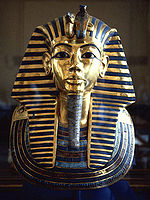 |
3050 – 30 BC | Egyptian pharaohs were kings of Ancient Egypt Ancient Egypt Ancient Egypt was an ancient civilization of Northeastern Africa, concentrated along the lower reaches of the Nile River in what is now the modern country of Egypt. Egyptian civilization coalesced around 3150 BC with the political unification of Upper and Lower Egypt under the first pharaoh... , and were considered by their culture to be gods. Their titles equated them with aspects of the likes of the hawk god Horus Horus Horus is one of the oldest and most significant deities in the Ancient Egyptian religion, who was worshipped from at least the late Predynastic period through to Greco-Roman times. Different forms of Horus are recorded in history and these are treated as distinct gods by Egyptologists... , the vulture goddess Nekhbet Nekhbet In Egyptian mythology, Nekhbet was an early predynastic local goddess who was the patron of the city of Nekheb, her name meaning of Nekheb... and the cobra-goddess Wadjet Wadjet In Egyptian mythology, Wadjet, or the Green One , was originally the ancient local goddess of the city of Dep , which became part of the city that the Egyptians named Per-Wadjet, House of... . The Egyptians believed that when their Pharaoh had died, he would continue to lead them in the next life, which is why his burial was grand and completed to perfection, to please him in the next life and ensure his immortality to protect his people. See List of pharaohs. |
| Naram-Sin |  |
2255–2119 BC | The first Mesopotamian king to claim divinity. |
| Chinese Emperors |  |
221 BC – AD 1911 | Deified as "Son of Heaven" since the Qin Dynasty Qin Dynasty The Qin Dynasty was the first imperial dynasty of China, lasting from 221 to 207 BC. The Qin state derived its name from its heartland of Qin, in modern-day Shaanxi. The strength of the Qin state was greatly increased by the legalist reforms of Shang Yang in the 4th century BC, during the Warring... under Qin Shi Huang Qin Shi Huang Qin Shi Huang , personal name Ying Zheng , was king of the Chinese State of Qin from 246 BC to 221 BC during the Warring States Period. He became the first emperor of a unified China in 221 BC... . |
| Roman Emperors |  |
42 BC – AD 363 | Following Julius Caesar Julius Caesar Gaius Julius Caesar was a Roman general and statesman and a distinguished writer of Latin prose. He played a critical role in the gradual transformation of the Roman Republic into the Roman Empire.... who in 42 BC was formally deified as "the Divine Julius" (Divus Iulius), and Caesar Augustus henceforth became Divi filius ("Son of the Divine One"), some (not all) Roman Emperors of the 1st to 4th centuries claimed divinity, including Tiberius Tiberius Tiberius , was Roman Emperor from 14 AD to 37 AD. Tiberius was by birth a Claudian, son of Tiberius Claudius Nero and Livia Drusilla. His mother divorced Nero and married Augustus in 39 BC, making him a step-son of Octavian... 14–37, Caligula Caligula Caligula , also known as Gaius, was Roman Emperor from 37 AD to 41 AD. Caligula was a member of the house of rulers conventionally known as the Julio-Claudian dynasty. Caligula's father Germanicus, the nephew and adopted son of Emperor Tiberius, was a very successful general and one of Rome's most... 37–41, Claudius Claudius Claudius , was Roman Emperor from 41 to 54. A member of the Julio-Claudian dynasty, he was the son of Drusus and Antonia Minor. He was born at Lugdunum in Gaul and was the first Roman Emperor to be born outside Italy... 41–54, Hadrian Hadrian Hadrian , was Roman Emperor from 117 to 138. He is best known for building Hadrian's Wall, which marked the northern limit of Roman Britain. In Rome, he re-built the Pantheon and constructed the Temple of Venus and Roma. In addition to being emperor, Hadrian was a humanist and was philhellene in... 117–138, Commodus Commodus Commodus , was Roman Emperor from 180 to 192. He also ruled as co-emperor with his father Marcus Aurelius from 177 until his father's death in 180. His name changed throughout his reign; see changes of name for earlier and later forms. His accession as emperor was the first time a son had succeeded... 161–192, Constantine I Constantine I Constantine the Great , also known as Constantine I or Saint Constantine, was Roman Emperor from 306 to 337. Well known for being the first Roman emperor to convert to Christianity, Constantine and co-Emperor Licinius issued the Edict of Milan in 313, which proclaimed religious tolerance of all... 306–312, Julian the Apostate Julian the Apostate Julian "the Apostate" , commonly known as Julian, or also Julian the Philosopher, was Roman Emperor from 361 to 363 and a noted philosopher and Greek writer.... 361–363 |
| Japanese emperors |  |
660 BC – | Claimed, at least by some Shintoists Shinto or Shintoism, also kami-no-michi, is the indigenous spirituality of Japan and the Japanese people. It is a set of practices, to be carried out diligently, to establish a connection between present day Japan and its ancient past. Shinto practices were first recorded and codified in the written... , including government officials, to be divine descendants of the goddess Amaterasu Amaterasu , or is apart of the Japanese myth cycle and also a major deity of the Shinto religion. She is the goddess of the sun, but also of the universe. the name Amaterasu derived from Amateru meaning "shining in heaven." The meaning of her whole name, Amaterasu-ōmikami, is "the great August kami who... . Hirohito Hirohito , posthumously in Japan officially called Emperor Shōwa or , was the 124th Emperor of Japan according to the traditional order, reigning from December 25, 1926, until his death in 1989. Although better known outside of Japan by his personal name Hirohito, in Japan he is now referred to... , the Showa emperor, repudiated this "false conception" in the Ningen-sengen Ningen-sengen is an imperial rescript issued by the Emperor Shōwa as part of a New Year’s statement on January 1, 1946 at the request of the Supreme Commander of the Allied Powers... in 1945. |
| Natchez rulers Natchez people The Natchez are a Native American people who originally lived in the Natchez Bluffs area, near the present-day city of Natchez, Mississippi. They spoke a language isolate that has no known close relatives, although it may be very distantly related to the Muskogean languages of the Creek... |
 |
700 | The Natchez were a theocracy ruled by "The Great Sun." This ruler has sometimes been deemed a God-king. |
| The Sailendra Sailendra Sailendra is the name of an influential Indonesian dynasty that emerged in 8th century Java.The Sailendras were active promoters of Mahayana Buddhism and covered the Kedu Plain of Central Java with Buddhist monuments, including the world famous Borobudur.The Sailendras are considered to be a... s |
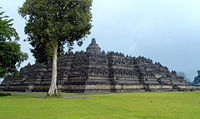 |
700 | The Sailendra Sailendra Sailendra is the name of an influential Indonesian dynasty that emerged in 8th century Java.The Sailendras were active promoters of Mahayana Buddhism and covered the Kedu Plain of Central Java with Buddhist monuments, including the world famous Borobudur.The Sailendras are considered to be a... dynasty of Java Java Java is an island of Indonesia. With a population of 135 million , it is the world's most populous island, and one of the most densely populated regions in the world. It is home to 60% of Indonesia's population. The Indonesian capital city, Jakarta, is in west Java... were active promoters of Mahayana Buddhism and covered the plains of Central Java Central Java Central Java is a province of Indonesia. The administrative capital is Semarang. It is one of six provinces on the island of Java.This province is the province of high Human Development in Indonesia and its Points Development Index countries is equivalent to Lebanon. The province of Central Java... with Buddhist monuments, including the world famous Borobudur Borobudur Borobudur, or Barabudur, is a 9th-century Mahayana Buddhist monument near Magelang, Central Java, Indonesia. The monument comprises six square platforms topped by three circular platforms, and is decorated with 2,672 relief panels and 504 Buddha statues... . |
| Dalai Lama Dalai Lama The Dalai Lama is a high lama in the Gelug or "Yellow Hat" branch of Tibetan Buddhism. The name is a combination of the Mongolian word далай meaning "Ocean" and the Tibetan word bla-ma meaning "teacher"... s |
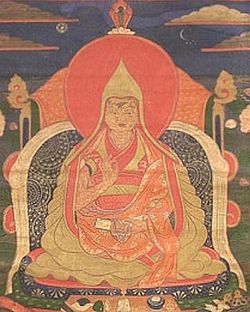 |
1391- | Considered re-incarnations of Avalokiteśvara Avalokitesvara Avalokiteśvara is a bodhisattva who embodies the compassion of all Buddhas. He is one of the more widely revered bodhisattvas in mainstream Mahayana Buddhism.... in Tibetan Buddhism Tibetan Buddhism Tibetan Buddhism is the body of Buddhist religious doctrine and institutions characteristic of Tibet and certain regions of the Himalayas, including northern Nepal, Bhutan, and India . It is the state religion of Bhutan... . Panchen Lama Panchen Lama The Panchen Lama , or Bainqên Erdê'ni , is the highest ranking Lama after the Dalai Lama in the Gelugpa lineage of Tibetan Buddhism... s are incarnations of Amitabha Buddha. |
| Inca Emperors |  |
1438 | The Inca Emperors had a status very similar to that of the Pharaohs of Egypt. |
| Ismail I of Persia | 1502–1524 | Self-claimed to be an emanation of God and was considered such by the Safaviya order, Turkem subjects and Alevis. | |
| Nepalese monarchs Nepalese monarchy The Kingdom of Nepal , also referred to as the Gorkha Kingdom, was formed in 1768 by the unification of Nepal. Founded by Prithvi Narayan Shah The Kingdom of Nepal , also referred to as the Gorkha Kingdom, was formed in 1768 by the unification of Nepal. Founded by Prithvi Narayan Shah The Kingdom... |
1768–2008 | Although Nepal Nepal Nepal , officially the Federal Democratic Republic of Nepal, is a landlocked sovereign state located in South Asia. It is located in the Himalayas and bordered to the north by the People's Republic of China, and to the south, east, and west by the Republic of India... was the birthplace of the Buddha Buddha In Buddhism, buddhahood is the state of perfect enlightenment attained by a buddha .In Buddhism, the term buddha usually refers to one who has become enlightened... , the kings of the Shah dynasty Shah dynasty The Shah dynasty was the ruling dynasty of the Kingdom of Nepal.-The Rajput Lineage :The former royal family of Nepal claims descent from the Parmar Rajput dynasty of the Narsinghgarh state in Malwa . The famous kings of the Malwa region were Raja Bhrathari, Samrat Vikramaditya, and Raja Bhoj.... were held to be incarnations of Vishnu Vishnu Vishnu is the Supreme god in the Vaishnavite tradition of Hinduism. Smarta followers of Adi Shankara, among others, venerate Vishnu as one of the five primary forms of God.... . |
Posthumous deification
| Who | Image | When | Notability |
|---|---|---|---|
| Imhotep Imhotep Imhotep , fl. 27th century BC was an Egyptian polymath, who served under the Third Dynasty king Djoser as chancellor to the pharaoh and high priest of the sun god Ra at Heliopolis... |
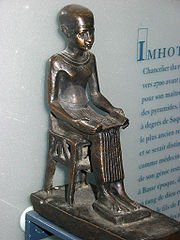 |
2600 BC | Ancient Egypt Ancient Egypt Ancient Egypt was an ancient civilization of Northeastern Africa, concentrated along the lower reaches of the Nile River in what is now the modern country of Egypt. Egyptian civilization coalesced around 3150 BC with the political unification of Upper and Lower Egypt under the first pharaoh... ian architect and physician, who two thousand years after his death, was raised to that of a god, becoming the god of medicine and healing. |
| Queen Dido of Carthage | 814 BC | Founder and first queen of Carthage Carthage Carthage , implying it was a 'new Tyre') is a major urban centre that has existed for nearly 3,000 years on the Gulf of Tunis, developing from a Phoenician colony of the 1st millennium BC... , after her death, she was deified by her people with the name of Tanit Tanit Tanit was a Phoenician lunar goddess, worshipped as the patron goddess at Carthage. Tanit was worshiped in Punic contexts in the Western Mediterranean, from Malta to Gades into Hellenistic times. From the fifth century BCE onwards Tanit is associated with that of Baal Hammon... and assimilated to the Great Goddess Astarte (Roman Juno). The cult of Tanit Tanit Tanit was a Phoenician lunar goddess, worshipped as the patron goddess at Carthage. Tanit was worshiped in Punic contexts in the Western Mediterranean, from Malta to Gades into Hellenistic times. From the fifth century BCE onwards Tanit is associated with that of Baal Hammon... survived Carthage's destruction by the Romans; it was introduced to Rome itself by Emperor Septimius Severus, himself born in North Africa. It was extinguished completely with the Theodosian decrees of the late 4th century. |
|
| Homer Homer In the Western classical tradition Homer , is the author of the Iliad and the Odyssey, and is revered as the greatest ancient Greek epic poet. These epics lie at the beginning of the Western canon of literature, and have had an enormous influence on the history of literature.When he lived is... (hero cult) |
 |
8th century BC | Venerated at Alexandria by Ptolemy IV Philopator Ptolemy IV Philopator Ptolemy IV Philopator , son of Ptolemy III and Berenice II of Egypt was the fourth Pharaoh of Ptolemaic Egypt... |
| Romulus and Remus Romulus and Remus Romulus and Remus are Rome's twin founders in its traditional foundation myth, although the former is sometimes said to be the sole founder... (hero cult) |
 |
771–717 BC | Founders of Rome Rome Rome is the capital of Italy and the country's largest and most populated city and comune, with over 2.7 million residents in . The city is located in the central-western portion of the Italian Peninsula, on the Tiber River within the Lazio region of Italy.Rome's history spans two and a half... , sons of Mars Mars (mythology) Mars was the Roman god of war and also an agricultural guardian, a combination characteristic of early Rome. He was second in importance only to Jupiter, and he was the most prominent of the military gods worshipped by the Roman legions... , Romulus served as first king. After his death, Romulus was defined as the god, Quirinus Quirinus In Roman mythology, Quirinus was an early god of the Roman state. In Augustan Rome, Quirinus was also an epithet of Janus, as Janus Quirinus. His name is derived from Quiris meaning "spear."-History:... , the divine persona of the Roman people. He is now regarded as a mythological figure, and his name a back-formation Back-formation In etymology, back-formation is the process of creating a new lexeme, usually by removing actual or supposed affixes. The resulting neologism is called a back-formation, a term coined by James Murray in 1889... from the name Rome, which may ultimately derive from a word for "river". Some scholars, notably Andrea Carandini Andrea Carandini Count Andrea Carandini is an Italian archaeologist specialising in ancient Rome. Among his many excavations is the villa of Settefinestre.... believe in the historicity of Romulus, in part because of the 1988 discovery of the Murus Romuli Murus Romuli Murus Romuli is the name given to a wall built to protect the Palatine Hill, the centermost of the Seven Hills of Rome, in one of the oldest parts of the city of Rome... on the north slope of the Palatine Hill in Rome. |
| Siddhārtha Gautama Buddha Gautama Buddha Siddhārtha Gautama was a spiritual teacher from the Indian subcontinent, on whose teachings Buddhism was founded. In most Buddhist traditions, he is regarded as the Supreme Buddha Siddhārtha Gautama (Sanskrit: सिद्धार्थ गौतम; Pali: Siddhattha Gotama) was a spiritual teacher from the Indian... |
563 BC(?) | Believed to be a god by some Mahayana Mahayana Mahāyāna is one of the two main existing branches of Buddhism and a term for classification of Buddhist philosophies and practice... sects, and worshipped as an avatar of Vishnu Vishnu Vishnu is the Supreme god in the Vaishnavite tradition of Hinduism. Smarta followers of Adi Shankara, among others, venerate Vishnu as one of the five primary forms of God.... by some Vaishnavas. |
|
| Hephaistion |  |
356–324 BC | Deified by Alexander the Great |
| Alexander III of Macedon the Great (hero cult) | 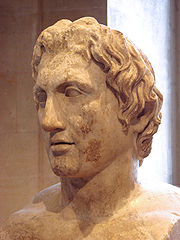 |
356–323 BC | Some believe he implied he was a demigod Demigod The term "demigod" , meaning "half-god", is commonly used to describe mythological figures whose one parent was a god and whose other parent was human; as such, demigods are human-god hybrids... by actively using the title "Son of Ammon Ammon Ammon , also referred to as the Ammonites and children of Ammon, was an ancient nation located east of the Jordan River, Gilead, and the Dead Sea, in present-day Jordan. The chief city of the country was Rabbah or Rabbath Ammon, site of the modern city of Amman, Jordan's capital... –Zeus Zeus In the ancient Greek religion, Zeus was the "Father of Gods and men" who ruled the Olympians of Mount Olympus as a father ruled the family. He was the god of sky and thunder in Greek mythology. His Roman counterpart is Jupiter and his Etruscan counterpart is Tinia.Zeus was the child of Cronus... ". The title was bestowed upon him by Egyptian priests of the god Ammon Ammon Ammon , also referred to as the Ammonites and children of Ammon, was an ancient nation located east of the Jordan River, Gilead, and the Dead Sea, in present-day Jordan. The chief city of the country was Rabbah or Rabbath Ammon, site of the modern city of Amman, Jordan's capital... at the Oracle Oracle In Classical Antiquity, an oracle was a person or agency considered to be a source of wise counsel or prophetic predictions or precognition of the future, inspired by the gods. As such it is a form of divination.... of the god at the Siwah oasis in the Libyan Desert Libyan Desert The Libyan Desert covers an area of approximately 1,100,000 km2, it extends approximately 1100 km from east to west, and 1,000 km from north to south, in about the shape of a rectangle... . |
| Mary, the mother of Jesus Mary (mother of Jesus) Mary , commonly referred to as "Saint Mary", "Mother Mary", the "Virgin Mary", the "Blessed Virgin Mary", or "Mary, Mother of God", was a Jewish woman of Nazareth in Galilee... |
~20/17 BC- | Some Christians, especially in the Eastern Orthodox Eastern Orthodox Church The Orthodox Church, officially called the Orthodox Catholic Church and commonly referred to as the Eastern Orthodox Church, is the second largest Christian denomination in the world, with an estimated 300 million adherents mainly in the countries of Belarus, Bulgaria, Cyprus, Georgia, Greece,... , Oriental Orthodox, and Eastern Catholic Churches, regard the Blessed Virgin Mary as the Theotokos Theotokos Theotokos is the Greek title of Mary, the mother of Jesus used especially in the Eastern Orthodox, Oriental Orthodox, and Eastern Catholic Churches. Its literal English translations include God-bearer and the one who gives birth to God. Less literal translations include Mother of God... (or Mother of God), although this does not mean that she is herself considered a deity. In 300 AD, however, she was worshipped as a Mother Goddess Mother goddess Mother goddess is a term used to refer to a goddess who represents motherhood, fertility, creation or embodies the bounty of the Earth. When equated with the Earth or the natural world such goddesses are sometimes referred to as Mother Earth or as the Earth Mother.Many different goddesses have... in the Christian sect Collyridianism, which was found throughout Saudi Arabia Saudi Arabia The Kingdom of Saudi Arabia , commonly known in British English as Saudi Arabia and in Arabic as as-Sa‘ūdiyyah , is the largest state in Western Asia by land area, constituting the bulk of the Arabian Peninsula, and the second-largest in the Arab World... . Collyridianism was made up mostly of women followers and female priests. Followers of Collyridianism were known to make bread and wheat offerings to the Virgin Mary, along with other sacrificial practices. The cult was heavily condemned as heretical and schismatic by the Roman Catholic Church Roman Catholic Church The Catholic Church, also known as the Roman Catholic Church, is the world's largest Christian church, with over a billion members. Led by the Pope, it defines its mission as spreading the gospel of Jesus Christ, administering the sacraments and exercising charity... and was preached against by Epiphanius of Salamis Epiphanius of Salamis Epiphanius of Salamis was bishop of Salamis at the end of the 4th century. He is considered a saint and a Church Father by both the Eastern Orthodox and Catholic Churches. He gained a reputation as a strong defender of orthodoxy... , who exposed the group in his recollective writings titled Panarion Panarion In early Christian heresiology, the Panarion , to which 16th-century Latin translations gave the name Adversus Haereses , is the most important of the works of Epiphanius of Salamis... . See Queen of Heaven Queen of Heaven Queen of Heaven is a title given to the Blessed Virgin Mary by Christians, mainly of the Roman Catholic Church, and also, to some extent, in the Anglican, Lutheran, and Eastern Orthodox churches, to whom the title is a consequence of the Council of Ephesus in the fifth century, where the Virgin... and Blessed Virgin Mary (Roman Catholic) Blessed Virgin Mary (Roman Catholic) Roman Catholic veneration of the Blessed Virgin Mary is based on Holy Scripture: In the fullness of time, God sent his son, born of a virgin. The mystery of the incarnation of the Son of God through Mary thus signifies her honour as Mother of God... for details. |
|
| Jesus Christ of Nazareth Jesus Jesus of Nazareth , commonly referred to as Jesus Christ or simply as Jesus or Christ, is the central figure of Christianity... |
 |
~4 BC – ~33 AD | In St. Paul the Apostle of Tarsus Paul of Tarsus Paul the Apostle , also known as Saul of Tarsus, is described in the Christian New Testament as one of the most influential early Christian missionaries, with the writings ascribed to him by the church forming a considerable portion of the New Testament... described Jesus as being the Son of God Son of God "Son of God" is a phrase which according to most Christian denominations, Trinitarian in belief, refers to the relationship between Jesus and God, specifically as "God the Son"... and the Lord. Bishop Athanasius Athanasius of Alexandria Athanasius of Alexandria [b. ca. – d. 2 May 373] is also given the titles St. Athanasius the Great, St. Athanasius I of Alexandria, St Athanasius the Confessor and St Athanasius the Apostolic. He was the 20th bishop of Alexandria. His long episcopate lasted 45 years Athanasius of Alexandria [b.... of Alexandria Alexandria Alexandria is the second-largest city of Egypt, with a population of 4.1 million, extending about along the coast of the Mediterranean Sea in the north central part of the country; it is also the largest city lying directly on the Mediterranean coast. It is Egypt's largest seaport, serving... wrote in defense of the divinity of the Holy Spirit Holy Spirit Holy Spirit is a term introduced in English translations of the Hebrew Bible, but understood differently in the main Abrahamic religions.While the general concept of a "Spirit" that permeates the cosmos has been used in various religions Holy Spirit is a term introduced in English translations of... , orthodox Christianity adopted his teachings at the First Council of Nicaea First Council of Nicaea The First Council of Nicaea was a council of Christian bishops convened in Nicaea in Bithynia by the Roman Emperor Constantine I in AD 325... in a Synod Synod A synod historically is a council of a church, usually convened to decide an issue of doctrine, administration or application. In modern usage, the word often refers to the governing body of a particular church, whether its members are meeting or not... assembly of bishops in 325 AD called by the Roman emperor Constantine I the Great. The Nicene Creed Nicene Creed The Nicene Creed is the creed or profession of faith that is most widely used in Christian liturgy. It is called Nicene because, in its original form, it was adopted in the city of Nicaea by the first ecumenical council, which met there in the year 325.The Nicene Creed has been normative to the... was formulated rejecting Arianism Arianism Arianism is the theological teaching attributed to Arius , a Christian presbyter from Alexandria, Egypt, concerning the relationship of the entities of the Trinity and the precise nature of the Son of God as being a subordinate entity to God the Father... (one of two major strains of Christian thought) and established Athanasianism Athanasian Creed The Athanasian Creed is a Christian statement of belief, focusing on Trinitarian doctrine and Christology. The Latin name of the creed, Quicumque vult, is taken from the opening words, "Whosoever wishes." The Athanasian Creed has been used by Christian churches since the sixth century... (Trinitarianism, the other strain) as "official doctrine." Jesus was declared to be God Incarnate Incarnation (Christianity) The Incarnation in traditional Christianity is the belief that Jesus Christ the second person of the Trinity, also known as God the Son or the Logos , "became flesh" by being conceived in the womb of a woman, the Virgin Mary, also known as the Theotokos .The Incarnation is a fundamental theological... , and is now considered to be God in most Christian views of Jesus Christian views of Jesus Christian views of Jesus are based on the teachings and beliefs outlined in the Canonical gospels, New Testament letters, and the Christian creeds. These outline the key beliefs held by Christian about Jesus, including his divinity, humanity, and earthly life. Generally speaking, adhering to the... , God the Son God the Son God the Son is the second person of the Trinity in Christian theology. The doctrine of the Trinity identifies Jesus of Nazareth as God the Son, united in essence but distinct in person with regard to God the Father and God the Holy Spirit... in Trinitarian Christianity. See History of early Christianity History of early Christianity The history of early Christianity covers Christianity before the First Council of Nicaea in 325.The first part of the period, during the lifetimes of the Twelve Apostles, is traditionally believed to have been initiated by the Great Commission of Jesus , and is called the Apostolic Age... , Pauline Christianity Pauline Christianity Pauline Christianity is a term used to refer to the Christianity associated with the beliefs and doctrines espoused by Paul of Tarsus through his writings. Most of orthodox Christianity relies heavily on these teachings and considers them to be amplifications and explanations of the teachings of... , Constantine the Great and Christianity and Christology Christology Christology is the field of study within Christian theology which is primarily concerned with the nature and person of Jesus Christ as recorded in the Canonical gospels and the letters of the New Testament. Primary considerations include the relationship of Jesus' nature and person with the nature... for details. |
| Antinous Antinous Antinoüs or Antinoös was a beautiful Bithynian youth and the favourite of the Roman emperor Hadrian... |
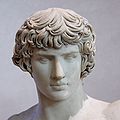 |
111 AD–130 AD | Deified by Hadrian Hadrian Hadrian , was Roman Emperor from 117 to 138. He is best known for building Hadrian's Wall, which marked the northern limit of Roman Britain. In Rome, he re-built the Pantheon and constructed the Temple of Venus and Roma. In addition to being emperor, Hadrian was a humanist and was philhellene in... . He is the last non-Imperial human to be formally deified in Western Civilization. |
| Guan Yu Guan Yu Guan Yu was a general serving under the warlord Liu Bei during the late Eastern Han Dynasty of China. He played a significant role in the civil war that led to the collapse of the Han Dynasty and the establishment of the state of Shu Han during the Three Kingdoms period, of which Liu Bei was the... |
 |
581 AD–618 AD | Guan Yu has been deified as early as the Sui Dynasty Sui Dynasty The Sui Dynasty was a powerful, but short-lived Imperial Chinese dynasty. Preceded by the Southern and Northern Dynasties, it ended nearly four centuries of division between rival regimes. It was followed by the Tang Dynasty.... and is still popularly worshipped today among the Chinese people variedly as an indigenous Chinese deity, a bodhisattva Bodhisattva In Buddhism, a bodhisattva is either an enlightened existence or an enlightenment-being or, given the variant Sanskrit spelling satva rather than sattva, "heroic-minded one for enlightenment ." The Pali term has sometimes been translated as "wisdom-being," although in modern publications, and... in Buddhism and a guardian deity in Taoism Taoism Taoism refers to a philosophical or religious tradition in which the basic concept is to establish harmony with the Tao , which is the mechanism of everything that exists... . He is also held in high esteem in Confucianism Confucianism Confucianism is a Chinese ethical and philosophical system developed from the teachings of the Chinese philosopher Confucius . Confucianism originated as an "ethical-sociopolitical teaching" during the Spring and Autumn Period, but later developed metaphysical and cosmological elements in the Han... . In Hong Kong Hong Kong Hong Kong is one of two Special Administrative Regions of the People's Republic of China , the other being Macau. A city-state situated on China's south coast and enclosed by the Pearl River Delta and South China Sea, it is renowned for its expansive skyline and deep natural harbour... both police and gangsters consider him to be a divine object of reverence. In certain schools of Taoism Taoism Taoism refers to a philosophical or religious tradition in which the basic concept is to establish harmony with the Tao , which is the mechanism of everything that exists... and Chinese Buddhism he has been deemed divine or semi-divine status. The reverence for him may date back to the Sui dynasty Sui Dynasty The Sui Dynasty was a powerful, but short-lived Imperial Chinese dynasty. Preceded by the Southern and Northern Dynasties, it ended nearly four centuries of division between rival regimes. It was followed by the Tang Dynasty.... . |
| Alī ibn Abī Ṭālib Ali ' |Ramaḍān]], 40 AH; approximately October 23, 598 or 600 or March 17, 599 – January 27, 661).His father's name was Abu Talib. Ali was also the cousin and son-in-law of the Islamic prophet Muhammad, and ruled over the Islamic Caliphate from 656 to 661, and was the first male convert to Islam... |
599 AD–661 AD | According to the Alawite Alawite The Alawis, also known as Alawites, Nusayris and Ansaris are a prominent mystical and syncretic religious group centred in Syria who are a branch of Shia Islam.-Etymology:... faith, Ali is one member of a trinity corresponding roughly to the Christian Father, Son, and Holy Spirit. |
|
| Sugawara no Michizane Sugawara no Michizane , also known as Kan Shōjō , a grandson of Sugawara no Kiyotomo , was a scholar, poet, and politician of the Heian Period of Japan... |
 |
845 AD–903 AD | Japanese Imperial courtier banished from the capital and deified upon his death to appease his angry spirit. Worshipped as Tenjin Tenjin (kami) In Japanese mythology and folklore, is the Shinto kami of scholarship, the deification of a scholar, poet, and politician named Sugawara no Michizane. Ten means sky and jin means god or deity... , kami Kami is the Japanese word for the spirits, natural forces, or essence in the Shinto faith. Although the word is sometimes translated as "god" or "deity", some Shinto scholars argue that such a translation can cause a misunderstanding of the term... of scholarship. |
| Al-Hakim bi-Amr Allah Al-Hakim bi-Amr Allah Abu ‘Ali Mansur Tāriqu l-Ḥākim, called Al-Hakim bi Amr al-Lāh , was the sixth Fatimid caliph and 16th Ismaili imam .- History :... |
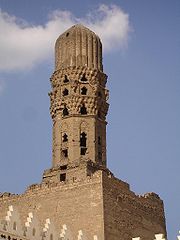 |
985 AD- 1021 AD | Sixth Fatimid Fatimid The Fatimid Islamic Caliphate or al-Fāṭimiyyūn was a Berber Shia Muslim caliphate first centered in Tunisia and later in Egypt that ruled over varying areas of the Maghreb, Sudan, Sicily, the Levant, and Hijaz from 5 January 909 to 1171.The caliphate was ruled by the Fatimids, who established the... Caliph in Egypt, ruling from 996 to 1021. Many of the druze Druze The Druze are an esoteric, monotheistic religious community, found primarily in Syria, Lebanon, Israel, and Jordan, which emerged during the 11th century from Ismailism. The Druze have an eclectic set of beliefs that incorporate several elements from Abrahamic religions, Gnosticism, Neoplatonism... believe he is an incarnation of God and that he will come back as the Mahdi Mahdi In Islamic eschatology, the Mahdi is the prophesied redeemer of Islam who will stay on Earth for seven, nine or nineteen years- before the Day of Judgment and, alongside Jesus, will rid the world of wrongdoing, injustice and tyranny.In Shia Islam, the belief in the Mahdi is a "central religious... |
| Majapahit Kings | 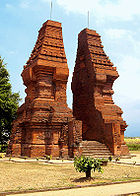 |
1293-1597 | Javanese rulers of South East Asia's largest ever kingdom, in Indonesia Indonesia Indonesia , officially the Republic of Indonesia , is a country in Southeast Asia and Oceania. Indonesia is an archipelago comprising approximately 13,000 islands. It has 33 provinces with over 238 million people, and is the world's fourth most populous country. Indonesia is a republic, with an... . After death, they were depicted as Hindu gods (see for instance Raden Wijaya Raden Wijaya Raden Wijaya was a Javanese King, the founder and the first monarch of Majapahit empire. The history of his founding of Majapahit was written in several records, including Pararaton and Negarakertagama... ). |
| L. L. Zamenhof L. L. Zamenhof Ludwig Lazarus Zamenhof December 15, 1859 – April 14, 1917) was the inventor of Esperanto, the most successful constructed language designed for international communication.-Cultural background:... |
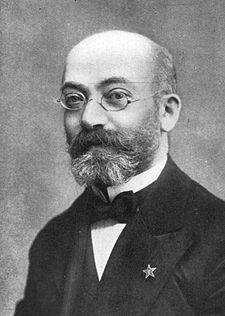 |
1859–1917 | Considered a god by members of the Oomoto Oomoto Oomoto also known as Oomoto-kyo , is a sect, often categorised as a new Japanese religion originated from Shinto; it was founded in 1892 by Deguchi Nao... religion. |
| Jose Rizal José Rizal José Protacio Rizal Mercado y Alonso Realonda , was a Filipino polymath, patriot and the most prominent advocate for reform in the Philippines during the Spanish colonial era. He is regarded as the foremost Filipino patriot and is listed as one of the national heroes of the Philippines by... |
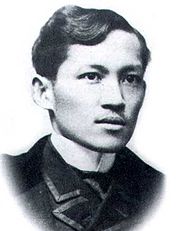 |
1861–1896 | Deified by some people in the Philippines Philippines The Philippines , officially known as the Republic of the Philippines , is a country in Southeast Asia in the western Pacific Ocean. To its north across the Luzon Strait lies Taiwan. West across the South China Sea sits Vietnam... due to his contributions to the Philippine Revolution Philippine Revolution The Philippine Revolution , called the "Tagalog War" by the Spanish, was an armed military conflict between the people of the Philippines and the Spanish colonial authorities which resulted in the secession of the Philippine Islands from the Spanish Empire.The Philippine Revolution began in August... . |
| Wallace D. Fard | ~1877 – ~1934 | Posthumously (?) deified by Elijah Muhammad Elijah Muhammad Elijah Muhammad was an African American religious leader, and led the Nation of Islam from 1934 until his death in 1975... . He is also given other titles by the Nation of Islam Nation of Islam The Nation of Islam is a mainly African-American new religious movement founded in Detroit, Michigan by Wallace D. Fard Muhammad in July 1930 to improve the spiritual, mental, social, and economic condition of African-Americans in the United States of America. The movement teaches black pride and... . |
|
| Kanichi Otsuka Shinreikyo Shinreikyo is a Japanese New Religion founded in 1947. It claims to have 100,000 members.-Founder:The group claims Kanichi Otsuka as its founder, but his wife Kunie Miyashitain also had a role in the development of the group. Kanichi Otsuka claimed to be a child prodigy and took the religious... |
1891 | Shinreikyo states of its founder "God became one with a human body, appeared among humanity, and founded Shinreikyo." | |
| George Washington George Washington George Washington was the dominant military and political leader of the new United States of America from 1775 to 1799. He led the American victory over Great Britain in the American Revolutionary War as commander-in-chief of the Continental Army from 1775 to 1783, and presided over the writing of... |
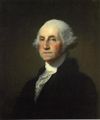 |
1732–1799 | Worshiped as a kami Kami is the Japanese word for the spirits, natural forces, or essence in the Shinto faith. Although the word is sometimes translated as "god" or "deity", some Shinto scholars argue that such a translation can cause a misunderstanding of the term... in Hawaii Hawaii Hawaii is the newest of the 50 U.S. states , and is the only U.S. state made up entirely of islands. It is the northernmost island group in Polynesia, occupying most of an archipelago in the central Pacific Ocean, southwest of the continental United States, southeast of Japan, and northeast of... an Shinto Shinto or Shintoism, also kami-no-michi, is the indigenous spirituality of Japan and the Japanese people. It is a set of practices, to be carried out diligently, to establish a connection between present day Japan and its ancient past. Shinto practices were first recorded and codified in the written... shrines. In the United States Capitol United States Capitol The United States Capitol is the meeting place of the United States Congress, the legislature of the federal government of the United States. Located in Washington, D.C., it sits atop Capitol Hill at the eastern end of the National Mall... dome, he is also depicted ascending into Heaven and becoming a god, in the famous painting called The Apotheosis of Washington The Apotheosis of Washington The Apotheosis of Washington is the immense fresco painted by Italian artist Constantino Brumidi in 1865 and visible through the oculus of the dome in the rotunda of the United States Capitol Building. The fresco is suspended above the rotunda floor and covers an area of . The figures painted are... . |
Involuntary deification
| Who | Image | When | Notability |
|---|---|---|---|
| Ezra HaSofer Ezra Ezra , also called Ezra the Scribe and Ezra the Priest in the Book of Ezra. According to the Hebrew Bible he returned from the Babylonian exile and reintroduced the Torah in Jerusalem... |
458 BC | Ezra established Second Temple Judaism Second Temple Judaism Second Temple Judaism refers to the religion of Judaism during the Second Temple period, between the construction of the second Jewish temple in Jerusalem in 515 BCE, and its destruction by the Romans in 70 CE This period witnessed major historical upheavals and significant religious changes that... and is regarded as a very important figure in Judaism. It is claimed in the Quran that Righteous Yemenite Jews Yemenite Jews Yemenite Jews are those Jews who live, or whose recent ancestors lived, in Yemen . Between June 1949 and September 1950, the overwhelming majority of Yemen's Jewish population was transported to Israel in Operation Magic Carpet... believed Uzair to be the son of God.. Many Jews believed that he never even died. |
|
| Antiochus II Theos Antiochus II Theos Antiochus II Theos was a king of the Hellenistic Seleucid Kingdom who reigned 261 BC – 246 BC). He succeeded his father Antiochus I Soter in the winter of 262–61 BC... |
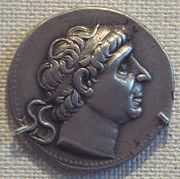 |
286–246 BC | Seleucid Seleucid Empire The Seleucid Empire was a Greek-Macedonian state that was created out of the eastern conquests of Alexander the Great. At the height of its power, it included central Anatolia, the Levant, Mesopotamia, Persia, today's Turkmenistan, Pamir and parts of Pakistan.The Seleucid Empire was a major centre... ruler. The younger son of Antiochus I and Stratonice Stratonice of Syria For other persons with the same name, see StratoniceStratonice of Syria was the daughter of king Demetrius Poliorcetes and Phila, the daughter of Antipater... , succeeded his father in 261. He liberated Ephesus, Ionia, Cilicia and Pamphylia from Egyptian domination, and in return for their autonomy the cities of Asia Minor gave him the title Theos ("God"). |
| Hernán Cortés Hernán Cortés Hernán Cortés de Monroy y Pizarro, 1st Marquis of the Valley of Oaxaca was a Spanish Conquistador who led an expedition that caused the fall of the Aztec Empire and brought large portions of mainland Mexico under the rule of the King of Castile in the early 16th century... |
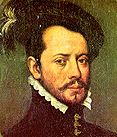 |
1471–1541 | Identified as Quetzalcoatl Quetzalcoatl Quetzalcoatl is a Mesoamerican deity whose name comes from the Nahuatl language and has the meaning of "feathered serpent". The worship of a feathered serpent deity is first documented in Teotihuacan in the first century BCE or first century CE... by Moctezuma II Moctezuma II Moctezuma , also known by a number of variant spellings including Montezuma, Moteuczoma, Motecuhzoma and referred to in full by early Nahuatl texts as Motecuhzoma Xocoyotzin, was the ninth tlatoani or ruler of Tenochtitlan, reigning from 1502 to 1520... |
| General John Nicholson | 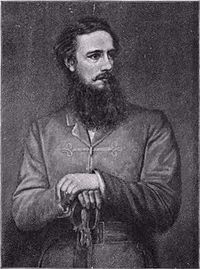 |
1822–1857 | Inspired the cult of Nikal Seyn. |
| Jiddu Krishnamurti Jiddu Krishnamurti Jiddu Krishnamurti or J. Krishnamurti or , was a renowned writer and speaker on philosophical and spiritual subjects. His subject matter included: psychological revolution, the nature of the mind, meditation, human relationships, and bringing about positive change in society... |
1895–1986 | Renounced the status of messiah and Maitreya incarnation given him by the Theosophical Society Theosophical Society The Theosophical Society is an organization formed in 1875 to advance the spiritual principles and search for Truth known as Theosophy. The original organization, after splits and realignments has several successors... . |
|
| Haile Selassie I of Ethiopia | 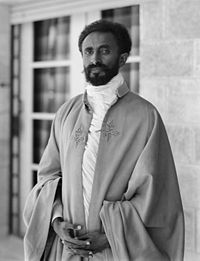 |
1892–1975 | Among most followers of the Rastafari movement Rastafari movement The Rastafari movement or Rasta is a new religious movement that arose in the 1930s in Jamaica, which at the time was a country with a predominantly Christian culture where 98% of the people were the black descendants of slaves. Its adherents worship Haile Selassie I, Emperor of Ethiopia , as God... , Haile Selassie is seen as God incarnate, the Black Messiah and "Earth's Rightful Ruler" who will also lead African peoples to freedom. Rastas say that his royal titles (i.e. King of Kings, Conquering Lion of the Tribe of Judah, and Root of David) were prophesied as belonging to the returned Messiah in Revelation Book of Revelation The Book of Revelation is the final book of the New Testament. The title came into usage from the first word of the book in Koine Greek: apokalupsis, meaning "unveiling" or "revelation"... . Their faith in his divinity first appeared in Jamaica Jamaica Jamaica is an island nation of the Greater Antilles, in length, up to in width and 10,990 square kilometres in area. It is situated in the Caribbean Sea, about south of Cuba, and west of Hispaniola, the island harbouring the nation-states Haiti and the Dominican Republic... , soon after his 1930 coronation in Addis Ababa Addis Ababa Addis Ababa is the capital city of Ethiopia... . Before his coronation he was called Ras (meaning Prince) Tafari. |
| Prince Philip of Greece and Denmark, Duke of Edinburgh Prince Philip, Duke of Edinburgh Prince Philip, Duke of Edinburgh is the husband of Elizabeth II. He is the United Kingdom's longest-serving consort and the oldest serving spouse of a reigning British monarch.... |
 |
1921– | Considered a god in the village of Yaohnanen Yaohnanen Yaohnanen, also spelled Ionhanen is a village located on the island of Tanna in Vanuatu, at about 6 km south-east of the island main town, Lenakel.It is well-known for the participation of its villagers to the Prince Philip Movement.... , a cargo cult Cargo cult A cargo cult is a religious practice that has appeared in many traditional pre-industrial tribal societies in the wake of interaction with technologically advanced cultures. The cults focus on obtaining the material wealth of the advanced culture through magic and religious rituals and practices... in Vanuatu Vanuatu Vanuatu , officially the Republic of Vanuatu , is an island nation located in the South Pacific Ocean. The archipelago, which is of volcanic origin, is some east of northern Australia, northeast of New Caledonia, west of Fiji, and southeast of the Solomon Islands, near New Guinea.Vanuatu was... . See Prince Philip Movement Prince Philip Movement The Prince Philip Movement is a religious sect followed by the Yaohnanen tribe on the southern island of Tanna in Vanuatu.The Yaohnanen believe that Prince Philip, Duke of Edinburgh, the consort to Queen Elizabeth II, is a divine being; the pale-skinned son of a mountain spirit and brother of John... . |
| Kumari | -? | These are little girls who are worshipped by both Hindus and Buddhists as the incarnation of the Hindu Hindu Hindu refers to an identity associated with the philosophical, religious and cultural systems that are indigenous to the Indian subcontinent. As used in the Constitution of India, the word "Hindu" is also attributed to all persons professing any Indian religion... Goddess Durga Durga For the 1985 Hindi Film of Rajesh Khanna see DurgaaIn Hinduism, Durga ; ; meaning "the inaccessible" or "the invincible"; , durga) or Maa Durga "one who can redeem in situations of utmost distress" is a form of Devi, the supremely radiant goddess, depicted as having eighteen arms, riding a lion... (in Nepal, Taleju). They are picked when they are prepubescent. and are worshipped until they reach puberty Puberty Puberty is the process of physical changes by which a child's body matures into an adult body capable of reproduction, as initiated by hormonal signals from the brain to the gonads; the ovaries in a girl, the testes in a boy... . Their cult is in South Asian countries, such as Nepal Nepal Nepal , officially the Federal Democratic Republic of Nepal, is a landlocked sovereign state located in South Asia. It is located in the Himalayas and bordered to the north by the People's Republic of China, and to the south, east, and west by the Republic of India... . See Kumari (children) |
Self-deification
| Who | Image | When | Notability |
|---|---|---|---|
| Jesus Christ of Nazareth Jesus Jesus of Nazareth , commonly referred to as Jesus Christ or simply as Jesus or Christ, is the central figure of Christianity... |
 |
~4 BC – ~33 AD | In , Jesus claims, "Before Abraham was, I Am," using the same revealed name that God gives to Moses in , "I Am." The Jews to whom Jesus was speaking picked up stones to stone him as a result of this saying, clearly showing that they understood his claim to be blasphemous. In , Jesus' blasphemous claims are the reason the Jewish High Priest sends him before Pilate to be crucified. That Jesus accepted this charge shows that he intended to communicate his deity. Later followers of Jesus understood his claim to deity and believed it on the basis of his resurrection. In St. Paul the Apostle of Tarsus Paul of Tarsus Paul the Apostle , also known as Saul of Tarsus, is described in the Christian New Testament as one of the most influential early Christian missionaries, with the writings ascribed to him by the church forming a considerable portion of the New Testament... described Jesus as being the Son of God Son of God "Son of God" is a phrase which according to most Christian denominations, Trinitarian in belief, refers to the relationship between Jesus and God, specifically as "God the Son"... and the Lord. Bishop Athanasius Athanasius of Alexandria Athanasius of Alexandria [b. ca. – d. 2 May 373] is also given the titles St. Athanasius the Great, St. Athanasius I of Alexandria, St Athanasius the Confessor and St Athanasius the Apostolic. He was the 20th bishop of Alexandria. His long episcopate lasted 45 years Athanasius of Alexandria [b.... of Alexandria Alexandria Alexandria is the second-largest city of Egypt, with a population of 4.1 million, extending about along the coast of the Mediterranean Sea in the north central part of the country; it is also the largest city lying directly on the Mediterranean coast. It is Egypt's largest seaport, serving... wrote in defense of the divinity of the Holy Spirit Holy Spirit Holy Spirit is a term introduced in English translations of the Hebrew Bible, but understood differently in the main Abrahamic religions.While the general concept of a "Spirit" that permeates the cosmos has been used in various religions Holy Spirit is a term introduced in English translations of... , orthodox Christianity adopted his teachings at the First Council of Nicaea First Council of Nicaea The First Council of Nicaea was a council of Christian bishops convened in Nicaea in Bithynia by the Roman Emperor Constantine I in AD 325... in a Synod Synod A synod historically is a council of a church, usually convened to decide an issue of doctrine, administration or application. In modern usage, the word often refers to the governing body of a particular church, whether its members are meeting or not... assembly of bishops in 325 AD called by the Roman emperor Constantine I the Great. The Nicene Creed Nicene Creed The Nicene Creed is the creed or profession of faith that is most widely used in Christian liturgy. It is called Nicene because, in its original form, it was adopted in the city of Nicaea by the first ecumenical council, which met there in the year 325.The Nicene Creed has been normative to the... was formulated rejecting Arianism Arianism Arianism is the theological teaching attributed to Arius , a Christian presbyter from Alexandria, Egypt, concerning the relationship of the entities of the Trinity and the precise nature of the Son of God as being a subordinate entity to God the Father... (one of two major strains of Christian thought) and established Athanasianism Athanasian Creed The Athanasian Creed is a Christian statement of belief, focusing on Trinitarian doctrine and Christology. The Latin name of the creed, Quicumque vult, is taken from the opening words, "Whosoever wishes." The Athanasian Creed has been used by Christian churches since the sixth century... (Trinitarianism, the other strain) as official doctrine. Jesus was affirmed as God Incarnate Incarnation (Christianity) The Incarnation in traditional Christianity is the belief that Jesus Christ the second person of the Trinity, also known as God the Son or the Logos , "became flesh" by being conceived in the womb of a woman, the Virgin Mary, also known as the Theotokos .The Incarnation is a fundamental theological... , and is now considered to be God in most Christian views of Jesus Christian views of Jesus Christian views of Jesus are based on the teachings and beliefs outlined in the Canonical gospels, New Testament letters, and the Christian creeds. These outline the key beliefs held by Christian about Jesus, including his divinity, humanity, and earthly life. Generally speaking, adhering to the... , God the Son God the Son God the Son is the second person of the Trinity in Christian theology. The doctrine of the Trinity identifies Jesus of Nazareth as God the Son, united in essence but distinct in person with regard to God the Father and God the Holy Spirit... in Trinitarian Christianity. See History of early Christianity History of early Christianity The history of early Christianity covers Christianity before the First Council of Nicaea in 325.The first part of the period, during the lifetimes of the Twelve Apostles, is traditionally believed to have been initiated by the Great Commission of Jesus , and is called the Apostolic Age... , Pauline Christianity Pauline Christianity Pauline Christianity is a term used to refer to the Christianity associated with the beliefs and doctrines espoused by Paul of Tarsus through his writings. Most of orthodox Christianity relies heavily on these teachings and considers them to be amplifications and explanations of the teachings of... , Constantine the Great and Christianity and Christology Christology Christology is the field of study within Christian theology which is primarily concerned with the nature and person of Jesus Christ as recorded in the Canonical gospels and the letters of the New Testament. Primary considerations include the relationship of Jesus' nature and person with the nature... for details. |
| Antiochus IV Epiphanes Antiochus IV Epiphanes Antiochus IV Epiphanes ruled the Seleucid Empire from 175 BC until his death in 164 BC. He was a son of King Antiochus III the Great. His original name was Mithridates; he assumed the name Antiochus after he ascended the throne.... |
215–164 BC | Seleucid Seleucid Empire The Seleucid Empire was a Greek-Macedonian state that was created out of the eastern conquests of Alexander the Great. At the height of its power, it included central Anatolia, the Levant, Mesopotamia, Persia, today's Turkmenistan, Pamir and parts of Pakistan.The Seleucid Empire was a major centre... ruler (reigned 175-164); the only Seleucid king to claim divine honors, calling himself Theos Epiphaneus "God Manifest" and Nikephoros "Bringer of Victory." Nearly conquered Ptolemaic Egypt Ptolemaic Kingdom The Ptolemaic Kingdom in and around Egypt began following Alexander the Great's conquest in 332 BC and ended with the death of Cleopatra VII and the Roman conquest in 30 BC. It was founded when Ptolemy I Soter declared himself Pharaoh of Egypt, creating a powerful Hellenistic state stretching from... , the primary rival of the Seleucids among the Diadochi Diadochi The Diadochi were the rival generals, family and friends of Alexander the Great who fought for the control of Alexander's empire after his death in 323 BC... states. Famously attempted to impose ancient Greek religion Ancient Greek religion Greek religion encompasses the collection of beliefs and rituals practiced in ancient Greece in the form of both popular public religion and cult practices. These different groups varied enough for it to be possible to speak of Greek religions or "cults" in the plural, though most of them shared... on the Jews Jews The Jews , also known as the Jewish people, are a nation and ethnoreligious group originating in the Israelites or Hebrews of the Ancient Near East. The Jewish ethnicity, nationality, and religion are strongly interrelated, as Judaism is the traditional faith of the Jewish nation... by persecution, leading to the Maccabean Revolt; remembered as a major persecutor in Jewish tradition. |
|
| Simon Magus Simon Magus Simon the Sorcerer or Simon the Magician, in Latin Simon Magus, was a Samaritan magus or religious figure and a convert to Christianity, baptised by Philip the Apostle, whose later confrontation with Peter is recorded in . The sin of simony, or paying for position and influence in the church, is... |
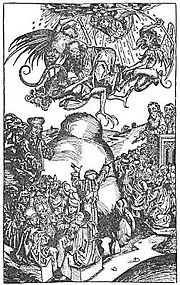 |
1st century | Considered a god in Simonianism Simonians The Simonians were a Gnostic sect of the 2nd century which regarded Simon Magus as its founder and traced its doctrines, known as Simonianism, back to him. The sect flourished in Syria, in various districts of Asia Minor and at Rome... . According to Irenaeus Irenaeus Saint Irenaeus , was Bishop of Lugdunum in Gaul, then a part of the Roman Empire . He was an early church father and apologist, and his writings were formative in the early development of Christian theology... , he "was glorified by many as if he were a god; and he taught that it was himself who appeared among the Jews as the Son, but descended in Samaria as the Father while he came to other nations in the character of the Holy Spirit. He represented himself, in a word, as being the loftiest of all powers, that is, the Being who is the Father over all, and he allowed himself to be called by whatsoever title men were pleased to address him." |
| Veleda Veleda Veleda was a völva of the Germanic tribe of the Bructeri who achieved some prominence during the Batavian rebellion of AD 69–70, headed by the Romanized Batavian chieftain Gaius Julius Civilis, when she correctly predicted the initial successes of the rebels against Roman... |
1st century | Germanic prophetess considered a deity during her lifetime. | |
| Danila Filippovich Khlysts Khlysts or Khlysty was an underground sect from late 17th to early 20th century that split off the Russian Orthodox Church and belonged to the Spiritual Christians tendency.-Definition:... |
1700 | He believed that he was God and started the Khlysts Khlysts Khlysts or Khlysty was an underground sect from late 17th to early 20th century that split off the Russian Orthodox Church and belonged to the Spiritual Christians tendency.-Definition:... . (There are various transliterations of his name including Danila Filipov, Danila Filipich, and Daniil Filippovich) |
|
| Hong Xiuquan Hong Xiuquan Hong Xiuquan , born Hong Renkun, style name Huoxiu , was a Hakka Chinese who led the Taiping Rebellion against the Qing Dynasty, establishing the Taiping Heavenly Kingdom over varying portions of southern China, with himself as the "Heavenly King" and self-proclaimed brother of Jesus Christ.-Early... |
 |
1814–1864 | Chinese man who claimed to be the younger brother of Jesus Jesus Jesus of Nazareth , commonly referred to as Jesus Christ or simply as Jesus or Christ, is the central figure of Christianity... and thus a son of God. Led the Taiping Rebellion Taiping Rebellion The Taiping Rebellion was a widespread civil war in southern China from 1850 to 1864, led by heterodox Christian convert Hong Xiuquan, who, having received visions, maintained that he was the younger brother of Jesus Christ, against the ruling Manchu-led Qing Dynasty... , conquering a large part of China before defeat and suicide. |
| Father Divine Father Divine Father Divine , also known as Reverend M. J. Divine, was an African American spiritual leader from about 1907 until his death. His full self-given name was Reverend Major Jealous Divine, and he was also known as "the Messenger" early in his life... |
~1880–1965 | Was considered by his followers to be "God in the flesh" | |
| Juanita Peraza (Mita) Juanita García Peraza Juanita Garcia Peraza, also known as "Mita" was the founder of the "Mita congregation", the only Protestant religion of Puerto Rican origin.-Early years:... |
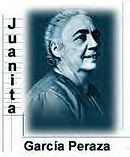 |
1897 | According to the Mita faith Mita Congregation The Mita Congregation is a Christian congregation based in Puerto Rico. The congregation has chapters in the United States, Canada, Venezuela, Colombia, Ecuador, Panama, Costa Rica, Mexico El Salvador, Spain, and in the Dominican Republic... , Mita (Peraza) was the incarnation of the Holy Ghost on earth. |
| Lou de Palingboer Lou de Palingboer Lou de Palingboer was the founder and figurehead of a new religious movement in the Netherlands.Lou was born Louwrens Voorthuijzen in Breezand. He had a strong religious interest from an early age, probably under the influence of his devout father. He chose the profession of fisherman... |
1898–1968 | A divorced Dutchman named Louwrens Voorthuijzen who proclaimed himself "Lou the Eel Vendor", this being the translation of his proclaimed name "Lou de Palingboer". He was a figure who mixed marketing European eels with proselytism. His followers also considered him a living God on a mission against evil. | |
| Jim Jones Jim Jones James Warren "Jim" Jones was the founder and leader of the Peoples Temple, which is best known for the November 18, 1978 mass suicide of 909 Temple members in Jonestown, Guyana along with the killings of five other people at a nearby airstrip.Jones was born in Indiana and started the Temple in... |
 |
1931–1978 | Founder of Peoples Temple Peoples Temple Peoples Temple was a religious organization founded in 1955 by Jim Jones that, by the mid-1970s, included over a dozen locations in California including its headquarters in San Francisco... , which started off as a part of a mainstream Protestant denomination Christian Church (Disciples of Christ) The Christian Church is a Mainline Protestant denomination in North America. It is often referred to as The Christian Church, The Disciples of Christ, or more simply as The Disciples... before becoming a personality cult as time went on. |
| Yahweh ben Yahweh Yahweh ben Yahweh Yahweh ben Yahweh was the adopted name of Hulon Mitchell, Jr. , founder and leader of the Nation of Yahweh, a black supremacist new religious movement founded in 1979.... |
1935–2007 | He was born as Hulon Mitchell, Jr. and his self-proclaimed name means "God, Son of God." He could have only been deeming himself to be "son of God", not God, but many of his followers clearly deem him to be God Incarnate. | |
| Nirmala Srivastava Nirmala Srivastava Nirmala Srivastava was the founder of Sahaja Yoga, a new religious movement... |
1923–2011 | Guru and goddess of Sahaja Yoga Sahaja Yoga Sahaja Yoga is a new religious movement founded by Nirmala Srivastava, more widely known as 'Shri Mataji Nirmala Devi' and affectionately as 'Mother' by her followers . According to the movement, Sahaja Yoga is the state of self realization produced by kundalini awakening and is accompanied by the... , has proclaimed herself to be the incarnation of the Holy Ghost (Adi Shakti Shakti Shakti from Sanskrit shak - "to be able," meaning sacred force or empowerment, is the primordial cosmic energy and represents the dynamic forces that are thought to move through the entire universe in Hinduism. Shakti is the concept, or personification, of divine feminine creative power, sometimes... ), claimed that all other incarnations (e.g. Krishna, Christ, etc.) were aspects of her. |
|
| Jehovah Wanyonyi Jehovah Wanyonyi Jehovah Wanyonyi lives in western Kenya, near Mount Elgon which he considers to be Mount Zion. He claims to be God and deems Jesus to be his son. He also claims to be able to cure AIDS and has stated that he would punish Kenya if they did not give him three billion Kenyan shillings . His religion... |
1924– | "I am the one who created Adam and Eve Adam and Eve Adam and Eve were, according to the Genesis creation narratives, the first human couple to inhabit Earth, created by YHWH, the God of the ancient Hebrews... . I made their bodies and their blood", […] "I still use human beings by speaking through them, like I spoke through Jesus Christ until he went to Heaven Heaven Heaven, the Heavens or Seven Heavens, is a common religious cosmological or metaphysical term for the physical or transcendent place from which heavenly beings originate, are enthroned or inhabit... ." There are between 120 and a 1000 followers who consider him God. |
|
| Sathya Sai Baba Sathya Sai Baba Śri Sathya Sai Baba , born as Sathyanarayana Raju was an Indian guru, spiritual figure, mystic, philanthropist, and educator. He claimed to be the reincarnation of Sai Baba of Shirdi, a spiritual saint and miracle worker who died in 1918 and whose teachings were an eclectic blend of Hindu and... |
1926–2011 | Hindu guru believed to be a reincarnation of an avatar Avatar In Hinduism, an avatar is a deliberate descent of a deity to earth, or a descent of the Supreme Being and is mostly translated into English as "incarnation," but more accurately as "appearance" or "manifestation".... of Dattatreya Dattatreya Dattatreya or Datta is a Hindu deity encompassing the trinity of Brahma, Vishnu and Shiva, collectively known as Trimurti. The name Dattatreya can be divided into two words - "Datta" and "Atreya" referring to the sage Atri, his physical father.Various Hindu sects worship him differently... by his followers. He alleged that he had the ability to materialize objects, such as jewellery, etc. |
|
| Osho (Bhagwan Shree Rajneesh) Osho (Bhagwan Shree Rajneesh) Osho , born Chandra Mohan Jain , and also known as Acharya Rajneesh from the 1960s onwards, as Bhagwan Shree Rajneesh during the 1970s and 1980s and as Osho from 1989, was an Indian mystic, guru, and spiritual teacher who garnered an international following.A professor of philosophy, he travelled... |
1931–1990 | In 1958 Rajneesh took the title "Bhagwan" which means "the embodiment of God". Thirty years later he admitted the title and his claim to be God were a "joke." Stating he was really the reincarnation of Buddha and claiming for himself the new title of "Rajneesh Gautaman the Buddha," Later he took the title, "Osho Rajneesh," a Buddhist term meaning "on whom the heavens shower flowers.". | |
| Matayoshi Jesus Matayoshi Jesus is a Japanese political activist, known for his perennial candidacy. He styles himself The only God Mitsuo Matayoshi Jesus Christ or Jesus Matayoshi . He is the leader of the World Economic Community Party .... |
1944– | In 1997 he established the World Economic Community Party (世界経済共同体党) based on his conviction that he is the God and Christ. | |
| Claude Vorilhon |  |
1946– | Claims to be Maitreya Maitreya Maitreya , Metteyya , or Jampa , is foretold as a future Buddha of this world in Buddhist eschatology. In some Buddhist literature, such as the Amitabha Sutra and the Lotus Sutra, he or she is referred to as Ajita Bodhisattva.Maitreya is a bodhisattva who in the Buddhist tradition is to appear on... , messenger of the "Elohim" (who are in fact ancient astronauts Ancient astronauts Some writers have proposed that intelligent extraterrestrial beings have visited Earth in antiquity or prehistory and made contact with humans. Such visitors are called ancient astronauts or ancient aliens. Proponents suggest that this contact influenced the development of human cultures,... ) |
| Vissarion Vissarion Sergey Anatolyevitch Torop , known by his followers as Vissarion , is a Russian mystic. He founded and heads a religious movement known as the Church of the Last Testament with its head church in the Siberian Taiga in the Minusinsk Depression east of Abakan, in the southern Siberia Kuraginsk... |
1961– | Claims to be Jesus Christ returned, which makes him not "God" but the "word of God" |
See also
- ApotheosisApotheosisApotheosis is the glorification of a subject to divine level. The term has meanings in theology, where it refers to a belief, and in art, where it refers to a genre.In theology, the term apotheosis refers to the idea that an individual has been raised to godlike stature...
- ArahitogamiArahitogamiis a Japanese word meaning a kami who is a human being.It first appears in Kojiki , but is assumed to have been used before this book....
- Divinity and Mortality
- Divine king
- Godman (Hindu ascetic)Godman (Hindu ascetic)A godman is a colloquial name for a particular type of charismatic guru who has a high-profile presence, is capable of attracting attention and support from Indian society, and makes claims of spiritual attainments...
- IncarnationIncarnationIncarnation literally means embodied in flesh or taking on flesh. It refers to the conception and birth of a sentient creature who is the material manifestation of an entity, god or force whose original nature is immaterial....
- List of avatar claimants
- List of Buddha claimants
- List of deities
- List of demigods
- List of messiah claimants
- List of people who have claimed to be Jesus
- Maitreya claimants
- Messiah complex (self-concept)
- People claiming to be the MahdiPeople claiming to be the MahdiIn Shia and Sunni eschatology, the Mahdi is a Messianic figure who, it is believed, will appear on Earth before the Day of Judgment and, alongside Jesus, will rid the world of wrongdoing, injustice and tyranny...
- Tat Tvam AsiTat Tvam AsiTat Tvam Asi , a Sanskrit sentence, translated variously as "That thou are," "Thou are that," "You are that," or "That you are," is one of the Mahāvākyas in Vedantic Sanatana Dharma...
- Thou Art GodThou Art GodThou Art God is a statement of divine immanence that is popular within Neopaganism and other religions. The phrase is also stated numerous times in the pages of Robert A...
External links
- Unknown (January 24, 2006) Heritage: Living gods face purge The Asian News

